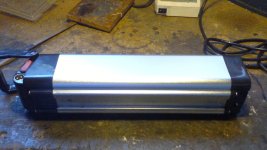A
Anonymous
Guest
Hi,
I bought a scooter and am moving all the grip shift, controller, batteries, cabling, to a bicycle.
I have currently got a cheap-ish 100 watt/ 120 watt controller for my scooter project conversion, sadly the controller won't turn the motor when I plug it in. it used to work when i plugged the motor in while the controller was on the scooter, but now after i removed the controller from the scooter completely and tried to reconnect it, i have wired it up wrong and not for love nor money will it spin the motor.

I have 2 more of these controllers so i am sure the controller hasn't burn out (no smoke, no arid fumes, nothing, the motor just won't work because I have not hooked it up correctly.
previously, when the controller was plugged into a 'fuse' and had a 'brake cable'(cut-out switch) attached to it it would turn the motor, so now i am at a loss as to whether.
1. it needs the fuse re-attached, and to which cable?
2. does it rely on having the brake cut-out as well? (deducting from answers below, this is a no it only needs the lock and derailleur assembly plugged in.
3: which cable goes where is a mystery to me, there are four red cables and two black ones. i also wouldn't assume the two black cables connect to one another because one of the black cables connected to the fuse (becoming a red cable) out the other end of the fuse plugging into the ''LOCK'' part of the controller.



here's another pic of the wire setup:


if anyone has had some experience with this then please help me, as I am at a loss as to what to do and do not want to burn the controllers out.
I have updated some pictures.
update: I have burnt out my first controller due to stupid wiring and have ordered another one off ebay, received the 2nd controller and was DOA, luckily the third one works and spins the motor but the throttle still doesn't work when I press it, it's definitely a wiring issue.
I bought a scooter and am moving all the grip shift, controller, batteries, cabling, to a bicycle.
I have currently got a cheap-ish 100 watt/ 120 watt controller for my scooter project conversion, sadly the controller won't turn the motor when I plug it in. it used to work when i plugged the motor in while the controller was on the scooter, but now after i removed the controller from the scooter completely and tried to reconnect it, i have wired it up wrong and not for love nor money will it spin the motor.

I have 2 more of these controllers so i am sure the controller hasn't burn out (no smoke, no arid fumes, nothing, the motor just won't work because I have not hooked it up correctly.
previously, when the controller was plugged into a 'fuse' and had a 'brake cable'(cut-out switch) attached to it it would turn the motor, so now i am at a loss as to whether.
1. it needs the fuse re-attached, and to which cable?
2. does it rely on having the brake cut-out as well? (deducting from answers below, this is a no it only needs the lock and derailleur assembly plugged in.
3: which cable goes where is a mystery to me, there are four red cables and two black ones. i also wouldn't assume the two black cables connect to one another because one of the black cables connected to the fuse (becoming a red cable) out the other end of the fuse plugging into the ''LOCK'' part of the controller.



here's another pic of the wire setup:


if anyone has had some experience with this then please help me, as I am at a loss as to what to do and do not want to burn the controllers out.
I have updated some pictures.
update: I have burnt out my first controller due to stupid wiring and have ordered another one off ebay, received the 2nd controller and was DOA, luckily the third one works and spins the motor but the throttle still doesn't work when I press it, it's definitely a wiring issue.




